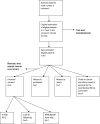A randomised controlled trial on the effectiveness of bracing patients with idiopathic scoliosis: failure to include patients and lessons to be learnt
- PMID: 20195651
- PMCID: PMC2899969
- DOI: 10.1007/s00586-010-1337-6
A randomised controlled trial on the effectiveness of bracing patients with idiopathic scoliosis: failure to include patients and lessons to be learnt
Abstract
Trials often do not succeed in including as many patients as anticipated beforehand. The aim of this paper was to describe why we were not able to include more than a few patients in our randomized controlled treatment trial on the effectiveness of bracing patients with idiopathic scoliosis, and to describe which lessons can be learnt. A pilot study on the willingness to participate in such a trial was conducted amongst 21 patients and their parents. A description of how we prepared and designed this trial, the problems we faced and how we tried to improve the inclusion are given. A total of four patients were included, and 14 refused to participate in an 18-month period. There were a lot less eligible patients than anticipated (40 instead of 100 per year), and the patients' participation rate was much lower than we had found in our pilot study (21% instead of 70%). The trial failed to include more than a few patients because of an overestimation of the number of eligible patients and because a lot less eligible patients were willing to participate compared to our pilot study. One reason for a low participation rate could be that this trial evaluated a frequently used existing treatment instead of a new treatment, and patients and parents might be afraid of not being treated (despite an intensive secure system for the control arm).
Figures


Similar articles
-
Preference assessment of recruitment into a randomized trial for adolescent idiopathic scoliosis.J Bone Joint Surg Am. 2008 Dec;90(12):2594-605. doi: 10.2106/JBJS.G.01460. J Bone Joint Surg Am. 2008. PMID: 19047704 Free PMC article.
-
An alternative to a randomised control design for assessing the efficacy and effectiveness of bracing in adolescent idiopathic scoliosis.Bone Joint J. 2015 Jul;97-B(7):973-81. doi: 10.1302/0301-620X.97B7.35147. Bone Joint J. 2015. PMID: 26130355 Clinical Trial.
-
Assessment of Adolescent and Parent Willingness to Participate in a Comparative Study of Scoliosis Braces.J Pediatr Orthop. 2025 Feb 1;45(2):75-80. doi: 10.1097/BPO.0000000000002840. Epub 2024 Oct 17. J Pediatr Orthop. 2025. PMID: 39466278
-
Standardization of criteria for adolescent idiopathic scoliosis brace studies: SRS Committee on Bracing and Nonoperative Management.Spine (Phila Pa 1976). 2005 Sep 15;30(18):2068-75; discussion 2076-7. doi: 10.1097/01.brs.0000178819.90239.d0. Spine (Phila Pa 1976). 2005. PMID: 16166897 Review.
-
Bracing for adolescent idiopathic scoliosis in practice today.J Pediatr Orthop. 2011 Jan-Feb;31(1 Suppl):S53-60. doi: 10.1097/BPO.0b013e3181f73e87. J Pediatr Orthop. 2011. PMID: 21173620 Review.
Cited by
-
Bracing Interventions Can Help Adolescents with Idiopathic Scoliosis with Surgical Indication: A Systematic Review.Children (Basel). 2022 Oct 31;9(11):1672. doi: 10.3390/children9111672. Children (Basel). 2022. PMID: 36360400 Free PMC article. Review.
-
Does brace treatment impact upon the flexibility and the correctability of idiopathic scoliosis in adolescents?Eur Spine J. 2013 Feb;22(2):268-73. doi: 10.1007/s00586-012-2477-7. Epub 2012 Aug 23. Eur Spine J. 2013. PMID: 22914876 Free PMC article.
-
Braces for idiopathic scoliosis in adolescents.Cochrane Database Syst Rev. 2015 Jun 18;2015(6):CD006850. doi: 10.1002/14651858.CD006850.pub3. Cochrane Database Syst Rev. 2015. PMID: 26086959 Free PMC article.
-
CONTRAIS: CONservative TReatment for Adolescent Idiopathic Scoliosis: a randomised controlled trial protocol.BMC Musculoskelet Disord. 2013 Sep 5;14:261. doi: 10.1186/1471-2474-14-261. BMC Musculoskelet Disord. 2013. PMID: 24007599 Free PMC article. Clinical Trial.
-
Polish Adaptation of the Italian Spine Youth Quality of Life Questionnaire.J Clin Med. 2021 May 12;10(10):2081. doi: 10.3390/jcm10102081. J Clin Med. 2021. PMID: 34066225 Free PMC article.
References
-
- Benard M, Juttmann RE (2001) Feasibility of an RCT on bracing patients with adolescent idiopathic scoliosis. Department of Public Health, Erasmus MC, Rotterdam
Publication types
MeSH terms
LinkOut - more resources
Full Text Sources
Medical
Molecular Biology Databases

